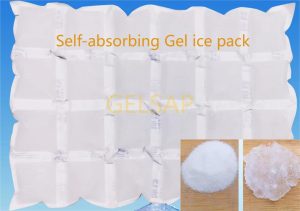If you’ve ever reached for an ice pack to soothe an injury or keep your lunch cool, chances are you’ve encountered the wonders of sodium polyacrylate. This incredible substance plays a crucial role in the efficiency and convenience of modern gel ice packs. Let’s delve into what sodium polyacrylate is, how it works in ice packs, and why these packs are a reusable marvel.

What is Sodium Polyacrylate?
Sodium polyacrylate is a type of superabsorbent polymer (SAP). Its chemical structure allows it to absorb and retain a vast amount of water relative to its own mass. This property makes it a valuable component in various products, from diapers and agricultural products to, of course, gel ice packs.
How Does Sodium Polyacrylate Work in Ice Packs?
In the context of gel ice packs, sodium polyacrylate is mixed with water and other ingredients to create a gel-like substance. This gel has several key characteristics:
- High Absorption Capacity: Sodium polyacrylate can absorb many times its weight in water, turning it into a thick gel. This gel consistency helps the ice pack mold to the contours of the body or the items it’s meant to cool, providing better coverage and more effective cooling.
- Extended Cooling Time: The gel retains cold temperatures for longer periods compared to plain ice. This is because the water is trapped in the gel structure, reducing the rate at which it warms up and melts.
- Reusability: Unlike traditional ice packs that need to be refilled or discarded after use, gel ice packs with sodium polyacrylate can be refrozen and reused many times. This makes them a cost-effective and environmentally friendly choice.
Why Are Sodium Polyacrylate Gel Ice Packs Reusable?
The reusability of sodium polyacrylate gel ice packs stems from their durable design and the properties of the gel itself. Here are some reasons why these packs are highly reusable:
- Durable Material: The outer layer of these ice packs is typically made from strong, flexible plastic that can withstand repeated freezing and thawing cycles without breaking or leaking.
- Stable Gel Structure: The gel formed by sodium polyacrylate retains its consistency even after multiple uses. It doesn’t break down or lose its effectiveness, ensuring long-lasting performance.
- Eco-Friendly: By reusing gel ice packs, you reduce waste and environmental impact compared to single-use alternatives. This aligns with growing consumer demand for sustainable products.
How to Use and Maintain Sodium Polyacrylate Gel Ice Packs
To get the most out of your reusable gel ice pack, follow these simple steps:
- Freezing: Place the ice pack in the freezer for several hours until it reaches the desired temperature. Ensure it lies flat to evenly distribute the gel.
- Application: Use the ice pack as needed, whether for cooling food, beverages, or soothing injuries. The flexible gel ensures it conforms to the shape of the surface it’s cooling.
- Storage: After use, wipe the pack clean with a damp cloth and return it to the freezer. Avoid puncturing the pack to maintain its integrity.
Conclusion
Sodium polyacrylate is the unsung hero in the world of gel ice packs. Its remarkable ability to absorb water and maintain a gel-like state enables these packs to offer superior cooling performance and reusability. By choosing sodium polyacrylate gel ice packs, you’re not only opting for convenience and effectiveness but also making a choice that’s better for the planet. Next time you need to keep something cool, reach for one of these gel ice packs and experience the difference for yourself.

